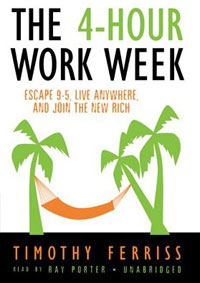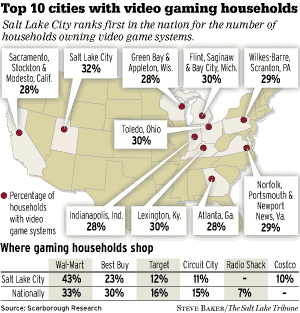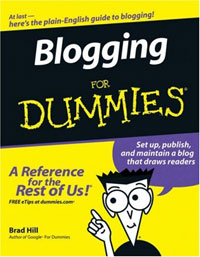 Even though Wal-Mart spreads like a germ, as evidenced in this video, times are changing (sorta).
Even though Wal-Mart spreads like a germ, as evidenced in this video, times are changing (sorta).
The Wall Street Journal reports: “Wal-Mart’s influence over the retail universe is slipping. In fact, the industry’s titan is scrambling to keep up with swifter rivals that are redefining the business all around it. It can still disrupt prices, as it did last year by cutting some generic prescriptions to $4. But success is no longer guaranteed.”
Note: I shop and buy groceries at Wal-Mart.

Mercury News
Microsoft released Halo 3 for Xbox 360 today. The game will sell millions, it’s already getting very good reviews, and Microsoft hopes (and needs) the game to be the biggest entertainment launch in history to reverse ongoing losses in its Xbox division.
“With nary a pirate, a spider or a wand in sight, day-one sales of [Halo 3] are expected to shatter entertainment sales records and top the biggest entertainment launches of all time,” Microsoft said in a statement. The current holder of that record is Sony’s Spider Man 3.
Over the weekend, Microsoft sent out what game journo Dean Takahashi called “propaganda: an $800 bribe (shown above) to convince the gaming press that Halo 3 is the biggest event of the year.” Takahashi says he’ll send the free loot back to Microsoft in an effort to tame the hype.
I could be wrong, but assuming Takahashi’s calculations are correct, the swag bag could be one of the most exorbitant press kits ever released. But will it serve its purpose in convincing the world by way of glowing coverage that Halo 3 is a mass media event that transcends rank and file video game enthusiasts like myself?
I’m not so sure.
Halo 3 needs to be more than a great game to achieve its commercial objectives. It needs to boost and maintain solid Xbox 360 sales which have slowed in a post-Wii world. It needs to offset the $10 million plus in marketing costs that Microsoft has so far shelled out. It needs to appeal to a lot more people than it has in the past even though the third installment is largely the same game.
But it will need more than an auspicious swag bag to accomplish all that, and I don’t think any game, regardless of who makes it, is that good.
Take it away, Mr. Jobs:
“We have decided to offer every iPhone customer who purchased an iPhone from either Apple or AT&T, and who is not receiving a rebate or any other consideration, a $100 store credit towards the purchase of any product at an Apple Retail Store or the Apple Online Store. Details are still being worked out and will be posted on Apple’s website next week… We want to do the right thing for our valued iPhone customers. We apologize for disappointing some of you, and we are doing our best to live up to your high expectations of Apple.”
Nice form. (Thanks, Nic!)
It might look something like this.
Gloob.tv, a phonetic portmanteau of glued and tube, is adding an editorial layer on top of the web’s billion-plus available videos; the idea being that editors know best when it comes to selecting the most desired user-submitted videos.
Published by Future US out of San Francisco, Gloob currently employs 26 editors or “spotters,” as they are called, to organize “the unwieldy world of online streaming video.” Spotters work on a rev-share basis being compensated for the traffic generated to their respective video selections.
And therein lies the difference in how Calacanis would do it; actually paying people to do the nitty-gritty as opposed to the insipid use of rev-share to drive traffic to a site that doesn’t have any revenue to begin with.
Continue reading at NewTeeVee…
 If someone told me in 1984 that you could successfully sell dolls to little boys for more than five consecutive years, I would have laughed at them. But that’s precisely what Hasbro (makers of Transfomers) and Playskool (makers of Playdough) did from 1985 into the early 90’s.
If someone told me in 1984 that you could successfully sell dolls to little boys for more than five consecutive years, I would have laughed at them. But that’s precisely what Hasbro (makers of Transfomers) and Playskool (makers of Playdough) did from 1985 into the early 90’s.
Granted, My Buddy wasn’t a smash or sustainable hit, but it clearly was profitable, albeit for a while. The lesson? Don’t let anyone tell you what you can and can’t take to market. I realize this idea encourages a lot of junk product being released, but in business, the best marketing wins, not necessarily the best product.
So the next time someone is drilling you on your marketing plan, just remember the doll intended for boys that had a run of success in the 80s. Remember My Buddy.
Despite its recent troubles, General Motors is the luckiest company in the world over the next few weeks according to Jalopnik. The car-loving blog — while heavily praising the movie’s entertainment value– says the highly-anticipated Transformers movie is basically a 144-minute commercial for GM. From the article:
“What makes this arrangement so amazing is that GM didn’t pay Paramount a single dime to get it done. That’s right — not a single penny changed hands between the big n’ beefy automaker and the big n’ beefy studio. Sure, GM provided some in-kind contributions of concept vehicles and the like, and of course they’ve got their own marketing budget running their own marketing campaign — but unlike other automakers, they didn’t drop a single pence into Paramount’s pocket for the privilege of having themselves featured in a movie [aimed at the coveted 15-35 male demographic, you know, the ones that buy a lot of cars] about cars that change into robots.”
Lucky…
NOTE: Transformers looks incredible! At first I thought the movie and its premise seemed too lame for the big screen, not to mention juvenile and over the top. But after seeing (and hearing) the amazing CG, cinematics, and deep sound, I cannot wait to see this film. “Autobots, transform. And roll out!” (spoiler-free review here)
As a professional blogger for nearly two years now, I’ve seen tens of thousands of comments aimed at me. Most of them are favorable, a lot of them are entertaining, some of them are negative, and a handful of them are just nasty. It comes with the territory when you publish your opinions, passions, and stories freely to the web.
But nasty commenters have a bright side. They help motivate me to work harder and make it so my output has to do the convincing. They give me thick skin and chutzpah to take risks as both a writer and businessman.
Continue reading…

In case you’ve forgotten, the US economy is ginormous. Strange Maps tells why:
Although the economies of countries like China and India are growing at an incredible rate, the US remains the nation with the highest GDP in the world – and by far: US GDP is projected to be $13.22 trillion (or $13,220 billion) in 2007, according to this source. That’s almost as much as the economies of the next four (Japan, Germany, China, UK) combined.
For even more context, click on the above US state map renamed for countries with similar economy sizes. Amazing…
Hat tip, USA.
Viral marketing goes by several different names — buzz marketing, disruptive marketing, guerilla marketing, annuity effect, long tail, media leverage and even word-of-mouth marketing. But adding the word “marketing” to viral or any of the aforementioned names is a bit of a misnomer as the act of marketing typically describes a direct and conscious act on the part of companies to pitch their products to consumers. Viral marketing is anything but conscious. It is indirect marketing managed by consumers and consumers alone.
By definition, viral marketing is a phenomenon that facilitates and encourages people to pass along a marketing message, usually — though not exclusively — online. Like a literal virus, the product message gets passed along from one user to the next and is easily shared in rapid fashion. Hotmail’s mandatory “Get your private, free e-mail at Hotmail.com” message on every outgoing e-mail is widely accredited as the first viral marketing campaign. Its strategy included:
Continue reading…
 Wow. Just wow. The 4-Hour Work Week is the most influential book I’ve read in years. Author Timothy Ferris, though a self-proclaimed extremist, dishes on slowing down your life, getting out of the rat race, outsourcing menial tasks, ditching your RSS feeds, batch processing email instead of checking it every 15 minutes (if not more), reducing unnecessary information consumption in favor of productivity and real learning, how effectiveness trumps efficiency, and how the idea of “retirement” is grossly flawed. In short as the book description tells, “Escape the 9-5, Live Anywhere, and Join the New Rich.”
Wow. Just wow. The 4-Hour Work Week is the most influential book I’ve read in years. Author Timothy Ferris, though a self-proclaimed extremist, dishes on slowing down your life, getting out of the rat race, outsourcing menial tasks, ditching your RSS feeds, batch processing email instead of checking it every 15 minutes (if not more), reducing unnecessary information consumption in favor of productivity and real learning, how effectiveness trumps efficiency, and how the idea of “retirement” is grossly flawed. In short as the book description tells, “Escape the 9-5, Live Anywhere, and Join the New Rich.”
Ferriss defines the new rich as those who favor mobility, experience, and service in favor of materialism. He counsels in great detail how to setup an automated online company for newbies (easier said than done, though possible) and how to focus your daily work efforts without letting fluff work get in the way. Best of all, Ferriss delivers it all in a very grounded, balanced, and hilarious way despite what his sensational title and clever tagline suggest. Overall, the book is unthinkably smart and of value to any person over the age of 18. I resolve from here on out to work smarter while striving to do what I love further still. That and more world travel, of course. 🙂
On that note, I’m planning my attempt to ditch the Internet for an entire year. I don’t have all the kinks figured out, and twice weekly email use will have to stay, but I will triumph within the next five years. Just you watch.
Those who know me well know I like video games. I don’t get to play them as much as I’d like to, but I do have the opportunity to write about them as a freelancer. So why is video game dialogue so cheesy? Why do I get embarrassed sometimes when my wife comes in the room only to find me suffering garbage line reading and poor scripts to get to the action? This is something of a pet-peeve for me as a hobbyist and something I recently wrote a feature on. From the article:
“The once fledgling video game industry with its minuscule budgets forced early game makers to wear several different hats, including storytelling ones even if they didn’t have prior experience. “When video games began, particularly on the PC, they were made by one, two, and three-person teams,” says Newsweek’s N’Gai Croal, a vocal proponent against amateur game dialogue. “Very few of these people had professional writing experience.”
As gaming grew to more than $14 billion a year, its storytelling failed to grow up with it. You can read the full article on Edge.
See 10 cons of the Web 2.0 movement. My favorite one: “Spelling and grammr (beta) have gone to hell in a handbasket. I’m in ur domainz, droppin’ ur vowelz.”
I’m guilty (during one fleeting moment in time). Are you?
A recent survey showed that 57% of respondent executives view user-generated content as one of the greatest threats to existing business models. Why is that? “Because they can’t control user-generated content, and they only know how to make money when they are in control of people,” says Jason Calacanis in an email to Smooth Harold. “Over time they will learn you can make money when your not in control–but that will take years.”
No wonder. Not being in control is a scary thing, especially when trying to turn a profit.
[Thanks, Jason]
Lon Safko has created one of the coolest, most efficient business models I’ve ever seen. He sells paper model designs to kids for $10 on his Yahoo! store.Here’s how it works: a kid logs on the site, selects a structure he wants to build, buys the pdf file using Mommy’s credit card, prints off the design, and builds it in under an hour using only paper, Elmer’s Glue, and scissors. Lon then makes off like a bandit only having to pay server fees and the cost of contracting new paper designs (if any). He markets the site using good ole fashion PPC arbitrage and proper SEO.Sweetness! Forget these fleeting, unproven “Web 2.0” companies. Money 1.0 for the win.
[via Scobleizer]
AOL launched a new tech blog on March 20 called Switched. In case you didn’t know, AOL also owns Engadget, the world’s largest tech blog that just so happens to be the world’s “most popular blog” according to Technorati in terms of linkage. Sources close to Smooth Harold report that Switched is even being funded better than Engadget in terms of salaried individuals despite having zero traffic (read: no ad sales). Yeah, that makes a lot of sense.
Venture with me — if you will — into the mind of one of the slowest internet dinosaurs in existence. “CEO: Okay, Switched spearhead. You think we should start a new tech blog even though we already own the number one tech blog that’s also the most visited weblog in the world? Okay. But won’t that cannibalize our traffic, at least with the non-tech savvy crowd (because you and I both know Engadget will continue to be the best tech blog unless we suffocate it)? And where Switched isn’t cannibalizing our efforts, won’t we just be wasting money rather than reinvesting into Engadget to further secure its dominance? No? Okay, I’m sold. I don’t know why we didn’t think about this before. Matter of fact, didn’t CNN.com just launch a new world news website to compete with itself? No? Well, they should have.”
Way to support your $25 million purchase of Weblogs Inc, AOL. Your CEO should be fired for letting this thing even see the light of day. I’m amazed by the stupidity and behind the scene agendas that are going on here. Peter Rojas and Ryan Block must be reeling from this mediocre move.
Friend, colleague, and referral ninja extraordinaire Chris Knudsen outlines six ways to become a better salesmen, Zig Ziglar not required. He writes: “Bottom line: solve problems, sell benefits not features, sell value, show value, listen, educate, have empathy and build real relationships. By doing these things correctly, I promise you will see a dramatic increase in your sales.”
I especially like Chris’s counsel to ask good open-ended questions that show the client you’re thinking about their pain areas and how to improve their business.
Continue reading…
USA Today: “Vonage has finally confirmed what many had feared: The embattled Internet phone company has no ‘workaround’ in hand to sidestep Verizon’s patented Internet phone technology… While Vonage has studied methods for designing around the patents, removal of the allegedly infringing technology, if even feasible, could take many months to fully study and implement.”
So unless a judge grants Vonage a permanent stay in light of the Verizon VOIP lawsuit, the company will most likely go under. At least for a few months, and I can’t wait that long without an office number.
Any other Vonage customers out there following the news?
 Snarky headline aside, Seth Godin — marketing author extraordinaire — got clever with his upcoming book tour and will make a fortune from it (further solidifying his staunch marketing prowess). He’ll also avoid being stuck in Fargo, North Dakota sans book sales in the process.
Snarky headline aside, Seth Godin — marketing author extraordinaire — got clever with his upcoming book tour and will make a fortune from it (further solidifying his staunch marketing prowess). He’ll also avoid being stuck in Fargo, North Dakota sans book sales in the process.
Here’s how it works: if a state populace raises at least $25,000 in pre-purchased books (his new one), Seth will come and speak free of charge to local residents. Grass root ninjas Matt Reinbold, Phil Burns, and Jason Alba have put together an impressive local campaign that’s sure to bring the acclaimed author to Utah. If interested, click here for the salient details on how to participate, or pledge your $50 now.
See also: Seth at Google HQ discussing what I believe to be his best work, All Marketers Are Liars (It’s the storytelling, stupid.)
[Thanks to all who sent this in]
From Lee Iacocca‘s book Where Have All the Leaders Gone?: “The President of the United States is given a free pass to ignore the Constitution, tap our phones, and lead us to war on a pack of lies. Congress responds to record deficits by passing a huge tax cut for the wealthy (thanks, but I don’t need it). The most famous business leaders are not the innovators but the guys in handcuffs. While we’re fiddling in Iraq, the Middle East is burning and nobody seems to know what to do. And the press is waving pom-poms instead of asking hard questions. That’s not the promise of America my parents and yours traveled across the ocean for. I’ve had enough. How about you?”
[via Kottke]

In case you didn’t know, Nintendo has been on a storm over the past year (I’m a big fan). Their stock has doubled over the past 12 months thanks to their nifty little DS handheld and motion-sensing Wii console.
So in commemoration of Letterman’s 60th birthday, Nintendo sent the late-night host a candid and personalized letter along with 2 handhelds and games that it’s pitching to an older generation, all with an insane amount of message consistency. The letter copy is far from the bloated stuff PR peeps normally send. Have a look for yourself.
Assuming Dave’s publicists personally delivers the loot, I’d be surprised if Letterman doesn’t name drop the product on his show. So let’s recap how to earn quality free media:
- Build a good product that’s in demand. You can’t make a ball roll up hill, neither can you with a crappy product.
- Get creative when pitching individuals, bloggers, newspapers, magazines, and TV personalities. Asking for coverage is lame. I’m amazed PR reps still do it. Get creative when pitching, and it better be good because bell cows have seen it all (see above example).
Despite being a celebrity, people still love free personalized goodies. Everyone has a flattering point. Make sure you product or service can do that, and it will be a lot easier to get free coverage.
If you haven’t already, go read Clive Thompson’s excellent Wired article on transparency in business and how it’s helping companies outperform the old way of doing things. “Fire the publicist. Go off message. Let all your employees blab and blog. In the new world of radical transparency, the path to business success is clear.”
And please. Let’s not turn “transparency” and “authenticity” into half-hearted memes. They should be guiding principles towards a better way of doing things in this Cluetrain world of ours.
My last year of business was the best ever. Griffio has yet to hit the growth stage in its 3.5 year life, but every year has been better than the last. Growth, albeit small. And I feel blessed.
However, I owe the tax man a hefty sum this year. I owe him even more for being a profitable LLC (darn pass-through entity). It’s funny because as I was sitting down with my tax adviser, I realized how much money I owe Uncle Sam. In the process I caught myself saying, “Man, I wish I incurred more losses so I wouldn’t have to pay so much. Why did I have to be profitable?” That’s brilliant.
Although I don’t agree where all my tax money goes, I’ll pay my dues appreciating the many opportunities this great economy has created for me. Does knowing that make it any easier to pay taxes? Maybe. At least that’s what I tell myself.
When I first started my company back in July of 2003, I was gun ho on proposals. I’d spend hours on ’em. They’d generally end up being 9-10 pages detailing what we intended to do on a project, but they were also filled with a lot of marketing fluff. I have since reduced the number of pages of my proposals/contracts focusing solely on scope and deliverables, and I now do something I should have always done; estimate first, then scope out a proposal.
I have been estimating first now for about a year and I can’t tell you how much time it has saved me. People have been estimating for years now, and I still don’t know why I didn’t take advantage of the idea earlier. Here’s how I put the very old best practice to work: when someone asks for a request for bid, I ask a few more detailed questions. I then get with my lead developer and estimate how much each “chunk” of work will cost. I’ll send back the totals, and assuming the client is satisfied, we’ll further the discussion to clearly define the scope of expectations and put together a final proposal or contract. Estimate options are, of course, subject to change as the initial scope can change.
I’m sure most of you have been smarter than me. So do you use estimates before bidding on work? If not, you should.
 According to a recent study, 32% of the city’s households own a video game system, more than any other metropolitan area in the nation. That’s what happens when teetotalers don’t spend their money on booze, or at one of state’s million plus restaurants. Mormons have to do something with their spare time…
According to a recent study, 32% of the city’s households own a video game system, more than any other metropolitan area in the nation. That’s what happens when teetotalers don’t spend their money on booze, or at one of state’s million plus restaurants. Mormons have to do something with their spare time…
I was at lunch today downing a delicious Green Chili Quesadilla from Bajio when I overheard to young bucks discussing sales strategies. They must have both been in their early twenties. The one doing the training was pitching the all too familiar and cliche “assuming the sale” method with a misconstrued twist. Here’s what he said, slightly paraphrased: “You just want to go to the door, and assume the sale. Don’t even ask them if they want to buy your product. Assume they do and move on to payment details, i.e. ‘How do you want to pay for this?'”
I couldn’t help but chuckle at the inexperience of these two knuckleheads. If this wasn’t amateurish, I don’t know what is? At the same time, I’m not the best salesman and could really take a cue from their ambitious “everyone will want our product” approach, but I always ask for the sale. Sometimes I ask several times to metaphorically pinch myself. I realize that’s a no-no on my part. Just today I was talking with an existing client about renewing a monthly consulting engagement. They already said “let’s go again,” but were out of town, so I was unable to formalize the repeat business until today. But I still asked and now realized the client must have been thinking, “Blake, shut up. Let’s do this. I shouldn’t have to tell you to assume the sale, you already freakin’ got it.”
So how do you define the “assuming the sale” strategy from both a salesman and consumer perspective? How have/haven’t you successfully used the method in your sales efforts?
This post comes courtesy of a good friend — Nicholas Roussos — as he so concisely describes and interesting event that transpired in public relations yesterday. First a little background. Sony’s newly launched PlayStation 3 is in a world of hurt. It costs a whopping $600 (Blu-ray included) and people aren’t buying it. The value proposition just isn’t there yet (if ever) on a mass scale. Note: PlayStation brings in 60% of Sony’s total profits.
So yesterday, the world’s largest gaming blog, Kotaku, leaked information that Sony would be releasing a new social networking tool heavily inspired by Nintendo’s and Microsoft’s already existing user-generated content efforts. Sony asks them not to run the story, but Kotaku rightfully does anyway.
About an hour later, Sony blackballs Kotaku from all company relations saying only information in the “public domain” will be made available to Kotaku in their coverage of Sony products. Kotaku publishes Sony’s archaic email ban and fittingly describes the biggest conflict of interest between PR and journalism in a respectful reply to Sony’s head of PR, Dave Karraker: “I think [your reaction] only highlights the differences that PR people and journalists have. My interest is not in making sure that Sony has positive news or that the timing of their news is correct, my job only is to inform the readers of news as quickly and accurately as I can.”
Immediately after Kotaku’s follow up post to their rumor, the internet implodes. Every single gaming blog is quick to criticize Sony’s reaction. The story reaches Digg’s homepage, and Sony’s already negative relationship with consumers spirals even further out of control, all in a matter of hours. Sony quickly caves, and reinvites Kotaku to all of their events, etc. Everything like it was before only Sony leaving having learned a valuable lesson. That is the online conversation changes everything, as Nic states “Cluetrain-style.” The above example shows Sony PR trying to do what traditional PR does; control the message and its timing. Kotaku makes that effort to control public and fosters more leverage against the mighty Sony corporation than it ever could alone. The online conversation is so powerful that even a company as big as Sony has to give in.
The most recent issue of Business 2.0 has a great article by Om Malik on hyperaggregation, or sites that aggregate other sites that do niche aggregation of a specific topic. For example, this blog is an aggregator of web, business, tech news, etc with a local Utah flare. My blog is also hyperaggregated by Connect Magazine that also aggregates other specific bloggers on a variety of topics though mostly focused on business issues. At some point Connect will likely post ads and start earning revenues merely by aggregating the best content. In theory, they will incur little to no content costs. The reason? People pay (in this case via attention and their time) for convenience, so as we get bombarded with even more worthwhile content, expect hyperaggregators to profitably compliment the big aggregators already out there.
Reading the article also makes me a bit sad to remember a project I was working on 9 months ago. It was an editorialized hyperaggregator built in WordPress that aimed to collect the best individual blog posts across a variety of topics. It was aptly named ContentDJ (one of the better site names I think I’ve come up with). Independent publishers signed up with our site for the chance to increase their exposure and ultimately take a cut in future ad revenues. I believe in a short few weeks with no exposure resulted in several hundred independent publishers. Sadly, my funding got cut, the site never left Alpha, and I currently don’t have the resources to keep it going though I still plan on seeing it realized.
On a related note, Griffio won a small account with Podango a few weeks ago to build a website for their newly launched Latest At… service which hyperaggregates the best of the best on big social websites like YouTube, MySpace, even PerezHilton.com. So take note: hyperaggretion will likely do very well in the coming months.
Don’t have time to read every popular business book out there? Read the book summaries at either Wikipedia or Wiki Summaries. These “Cliff Notes” of sorts work great for buzz terms, new ideas, and heavy meme books like the following:
The list could go on and on. Just Wiki a popular book and have at it. Of course, this isn’t a substitute for that excellent thing called actual reading, but it’s a great way to stay up to date, if not refresh yourself on the key ideas of emerging (or repackaged) concepts in business.
It has been said that almost 80% of all IT projects go over schedule and budget. That’s huge. And since I build web software for a living, I’ve had my share of mistakes. But fortunately, I learned early on that superior project management can significantly curtail delays and rising costs thus increasing the chances of a client leaving happy.
Over the past two years, Griffio has completed 92% of its projects on time and 84% under budget. I’m very proud of that result and hope the trend continues as I learn knew ways of speeding up the development process through better communication. So why do most IT projects fail? Information Week writes: “Technology projects very seldom fail for technology reasons. By far the highest percentage of failures results from human communication issues.”
In short, good project management is a must. And good project management is all about managing both client and developer expectations. For example, what specifically is included in an engagement, and more importantly, what’s not. Have an open door policy and don’t be afraid to lay your feelings out on the table when problems arise (and they will). Project management isn’t rocket science. It’s just good ole fashion accountability using delivery milestones, progress updates, and honesty up front when things aren’t going as planned.
Steve Jobs posted an excellent article today backing a DRM-less music file for the masses. That means you play the file when you want and where you want independent of music players. Even iPods. From Jobs’s callout to the big four record companies: “If [DRM] were removed, the music industry might experience an influx of new companies willing to invest in innovative new stores and players. This can only be seen as a positive by the music companies… Convincing them to license their music to Apple and others DRM-free will create a truly interoperable music marketplace. Apple will embrace this wholeheartedly.”
UPDATE: iTunes currently protects songs that are already DMR-less at emusic.com. Not to side with the big record lables, but perhaps Steve is up to something else. More here.
Connect Magazine has a fairly new ad campaign aimed at soliciting user-generated feedback from its readers. The campaign shows close-ups of several individuals (some prominent) with the quoted text, “I’m Editor-in-Chief,” suggesting that anyone can make recommendations for improvement. That’s a good thing. So it is in this public forum and with the utmost respect that I offer the following two suggestions after reading the first article from the magazine’s January issue (Nota bene: The online version only contains half of the print formatting problems I’ll discuss below):
-
Reference yourself as a proper noun. As you’ll see on both the online and print versions of Connect Magazine, the publication always references itself in-paragraph as “connect” sans capitalizing the “c” despite their being a proper noun. The reason — I suspect — is because the publication uses all lowercase letters in their logotype like several other companies do including my own. But the war waged against uppercase proper nouns in writing will never be won. Rather, the attempt in creating an exception to the rule is confusing to readers, and frankly, looks amateurish; like something a brash mom-and-pop shop would do shortly after creating their first company name. People don’t expect proper English on a creative logo, but they do expect it when reading copy. So ditch the lowercase “c” at the paragraph level if you want to mitigate confusion.
-
Quit changing the font type, its size, or its color in-paragraph. In paper form, Connect now uses a bright orange (its corporate color) when referencing itself or its URL in addition to snubbing conventional proper nouns. It also appears that they change the font type and its size a bit. This issue is largely more problematic that the first. It significantly reduces the readability by disrupting text continuity. The overall reading experience feels like that of driving your car over those annoying speed bumps in front of elementary schools. I’m betting the magazine did this in a vane attempt to combat the reader confusion cited above, which — if accurately assumed — would be ridiculous. And no, just because online articles can get away with colored hyperlinking doesn’t mean you can in print form. You’re a magazine not a website!
The above two suggestions are sure to increase the professionalism, usability, and most importantly, the readability of an already excellent publication. After all, Connect sells reading material for a living. They’d be wise not to alienate that experience for creativity’s sake or ambitious differentiation.
Disclosure: I write for Connect.
Dell lost its position as the number one PC manufacturer last year to HP. Though I used to swear by Dells, their prices have increased while their quality has rapidly decreased, hence, the last PC I bought was an HP. So what’s behind Dell’s recent funk? Bureaucracy says the newly appointed CEO, Michael Dell. “We have great people … but we also have a new enemy: bureaucracy, which costs us money and slows us down,” Dell wrote. “We created it, we subjected our people to it and we have to fix it!” Note: No one can fix bureaucracy, but transparency sure can help mitigate it. But come to think of it, I can’t think of any very large company that manages it well. You?
 Utah Business, which is generally a pretty poopsky magazine with very trite articles, has a nice little read on the key benefits of blogging. They dub keeping tabs on what’s going on in your space by reading blogs as the first benefit of blogs and the marketing power via publishing a blog. Here’s a nice blogging for dummies description from the article: “A corporate blog can enhance a company’s brand, build thought leadership, deepen customer relationships by promoting conversations and put forth a human face to a large organization. A blog also provides fresh web content, which gives you more online visibility, attracts search engines and drives more traffic.”
Utah Business, which is generally a pretty poopsky magazine with very trite articles, has a nice little read on the key benefits of blogging. They dub keeping tabs on what’s going on in your space by reading blogs as the first benefit of blogs and the marketing power via publishing a blog. Here’s a nice blogging for dummies description from the article: “A corporate blog can enhance a company’s brand, build thought leadership, deepen customer relationships by promoting conversations and put forth a human face to a large organization. A blog also provides fresh web content, which gives you more online visibility, attracts search engines and drives more traffic.”
My only beef; if you decide to publish a company blog, don’t call it a “corporate blog.” Just call it a blog. Personable. Authentic. Sans spin. No direct selling. Blogging: taking the corporate out of companies since 1999. I should trademark that.
Business 2.0 has published their 101 dumbest business moments of 2006. Here’s one of my favorites: “In August, RadioShack fires 400 staffers via e-mail. Affected employees receive a message that reads, “The work force reduction notification is currently in progress. Unfortunately your position is one that has been eliminated.” I think I’m going to start apologizing to my wife via email now. Less confrontational.
And who can forget the AOL “retention consultant” from Utah who wouldn’t let some guy cancel his account. Madness. Click onward for the full list of mediocrity.
Mirror, mirror, on the wall, who sues most of all? These 10 companies based on trademark lawsuits from 2001-2006 taken from the sidebar of this article:
- Microsoft
- Cendent
- Altria/Philip Morris
- Best Western
- Dunkin’ Donuts
- Lorillard Tobacco
- Levi Strauss
- Baskin-Robbins
- Chanel
- Nike
So what can be gleamed from this info? Either these companies are overprotective or have several others infringing on their IP.
[via Kottke]
A blog can be an excellent tool for building “You Inc.” For those out of the loop, a blog is nothing more than an easily updateable Web site intended to inform or influence. Here are eight things to avoid while blogging to help attract site visitors, garner trust, heighten exposure and increase revenues. Continue reading…
Rondam Ramblings has compiled their top 10 business myths:
- A brilliant idea will make you rich
- If you build it they will come
- Someone will steal your idea if you don’t protect it
- What you think matters
- Financial models are bogus
- What you know matters more than who you know
- A Ph.D. means something
- I need $5 million to start my business
- The idea is the most important part of my business plan
- Having no competition is a good thing
Follow the source link for the full skinny.
Several months ago, I was conducting interviews on a panel for a company I worked for. The panel interviewed about 8 different individuals. Sadly, what I remember most about the process, even more than the two individuals that actually got hired, was the second prospective employee interview. He was a young buck right out of college, a little eccentric, and simply wasn’t what the position required. You could just tell.
After thanking the applicant for coming in, he stood up, pointed to himself with both thumbs in the air and said, “I’m your guy! Let me just tell you that I’m your guy!” Don’t tell me you’re my guy, show me! Worse still, who taught this kid to do this? Needless to say, it was an awkward moment.
I’ve had my fair share of bad interviewee experiences too, however. About three years ago, I was interviewed by Payless Shoe Source for some corporate position (don’t ask, not that there’s anything wrong with that, I’m just a Nike guy). The company had found my student resume while I attended BYU, and invited me to interview. I was flattered and obliged, but neither I nor the interviewer were impressed. I remember at the end asking him what he liked most about working for the discount shoe company, and his response was that he got to “wear business casual instead of suits.” It was awkward, funny, and yet, a little sad at the same time. I can’t imagine the primary reason for working somewhere to be the wearing of casual attire, that is, unless you have an unusual fetish for sweatpants.
Steve Pavlina writes: “Having been a non-employee for about 14 years now, I’ve made my share of stupid business mistakes. I’ve also coached a number of people to start their own businesses, and I’ve seen many of them make similar mistakes.” Continue reading…
I’m currently reading Love is The Killer App. Though not the most prolific business book, the title does an excellent job in formulating what makes for a successful business career in terms of happiness and producing a return on your “networks.” Author Tim Sanders defines a “lovecat” as an individual that intelligently and sensibly shares his/her knowledge, network of friends and associates, and compassionate service with bizpartners without expecting anything in return.
What’s a bizpartner you may ask? Every person in our work life, be it a boss, banker, competitor, client, or just about anyone else. I especially like the competitor one and have recently discovered how much of an asset and help they can be for any type of business striving to improve.
Continue reading…
For all you salesman out there (which is just about anyone who tries to influence others), here are three of the most consistent prospecting methods:
-
Asking for referrals. Remember to always ask clients, colleagues, even prospects if they know anyone who could benefit from your services.
-
Executive Networking. Let your work speak for itself. Get your client CEO’s to call or email others in their industry on your behalf. Executive-to-executive sales will always outperform seller-to-executive sales.
-
Cold Calling. Yup. That’s right. Contrary to popular belief, the reason this method keeps re-occurring in sales is that it works. No other method can increase your prospecting efforts like cold calling can. (I have personally closed many profitable clients this way.)
There are lots of other ways to build your pipelines, but hopefully this will prioritize them and remind you of what works.
[Source: Power Prospecting by Patrick Hansen]
Because it’s written for already good companies. A majority of US businesses being run by entrepreneurs have yet to prove themselves. Therefore, I would like to see From Nothing to Good. Then I’ll focus on taking my company the rest of the way.
I only got through half his book, but plan on finishing it once I’m good.
Small business employees have the opportunity to wear many hats. My main “hat” for example says Project Manager, which is a fancy way of saying I take care of and manage all client projects and make sure they’re done on time. I’m also an HTML designer, proposal writer, secretary, general manager and even a salesman from time to time.
So what makes a good salesman? Well that question would be like asking, “What makes a good baseball team?” or “What makes a good human being?” for that matter. There are obviously many functions involved in answering the above questions. With that said, however, I do believe one thing is common in all great salesmen.
Continue reading…
There is a plethora of business books out in the world claiming to reveal the next big thing to make money or better run your business. Some are good, most are bad. There are books on management, sales, and even customer service. The last one I think is laughable. Customer service is equivalent to how you cordially serve your customers to make them happy. If you don’t understand that, I don’t know how you would be in business.
I therefore present Griffio’s “corporate policy” on customer service. It’s rather simple and is based on one thing: accountability. Be responsive to those you interact with. Here’s how:
-
Return phone calls within 1.5 hours – it’s tough, but it can be done. You will be surprised how comforting a returned phone call can be to your customers. By your doing it, they will have more respect for you and your company.
-
Reply to emails on the same day – When someone writes an email, respond to it. It usually takes about 10 seconds to do so. I recently emailed a gentleman last week inquiring about his marketing services. I still haven’t heard from him. My bet is that if he treats his potential customer’s poorly, a paying customer probably won’t get much response from him either.
Reason being: customer service is about character not dollars. It’s something that is hard to teach although it can be done. The two above items should help your efforts in showing your customers that you care enough to respond to them. They have been the only formal customer service policies we follow and have taken our company a long way in being one of the most responsive firms in our industry. Sure beats reading a long, boring business book on customer service.
Some of you may like to know: exactly how does Griffio go about solving our clients’ business challenges? Well, we’ve loosely documented but rigidly followed the below ideology. (It applies to all sorts of problems and not just how to make web-based business software.)
-
Discover. Find out what the problem is. A lot of times, you can just ask, “What’s the problem?” or “How can I make your job easier?” Otherwise, conduct in-depth research, such as thorough exploration and investigation to expose the predicament.
-
Design. After you understand where the problem is, you need to think it through. What ways can you solve the issue? What would work best? Continued research must take place to test your ideas during this phase. Contrary to popular problem solving formulas, this is where most of the testing should take place. An example would be how a certain web page will work or how my audience would react to this idea. Try to uncover any potential hang-ups the idea or process may have.
-
Develop. Create or build the supporting materials. This step generally includes the use of technical tools such as a software editor, a hammer, or even written notes. Good craftsmanship must take place to ensure quality.
-
Deliver. Once the system or idea is built or completed, deliver it, launch it, present it, or sell it. This is the part where you give and/or tell the “problemee” what you think will best improve their current state.
-
Support. This is where you help implement you solution, be it an idea or website. Problem solving requires change, both logistical and behavioral. Good support facilitates that change. The audience should be free to ask questions or get training as to how to best use your idea.
Hopefully, this will help or add to how you approach problems. The idea is to use these steps or a derivative of them in solving just about anything. If you come up with any areas that this might not work (i.e. marriage) please let me know by filling out our quick and easy comment box.
 I get asked now and then how I came up with the name of my company, Griffio. Here’s the answer:
I get asked now and then how I came up with the name of my company, Griffio. Here’s the answer:
In the summer of 2003, Dave Andersen (my first partner) and I were trying to decide on a name for our new web company. We created a long list of prospective words. Some good. Some not. Some flat out silly.
Anyhoo, I was reading an article one day by an Italian author named Griffo. At that time, I was also mentoring with a gentleman from Experio (now known as Hitachi Consulting). I liked the “io” in Experio and the “g” in Griffo. So I experimented with the two words until Griffio came out. The name stuck. Armed with an art degree, my sister Lexia told me to emphasize the “g” in the logomark. That stuck, too.
So there you have it. That’s how Griffio came to be.
 Even though Wal-Mart spreads like a germ, as evidenced in this video, times are changing (sorta).
Even though Wal-Mart spreads like a germ, as evidenced in this video, times are changing (sorta).








 I get asked now and then how I came up with the name of my company, Griffio. Here’s the answer:
I get asked now and then how I came up with the name of my company, Griffio. Here’s the answer: